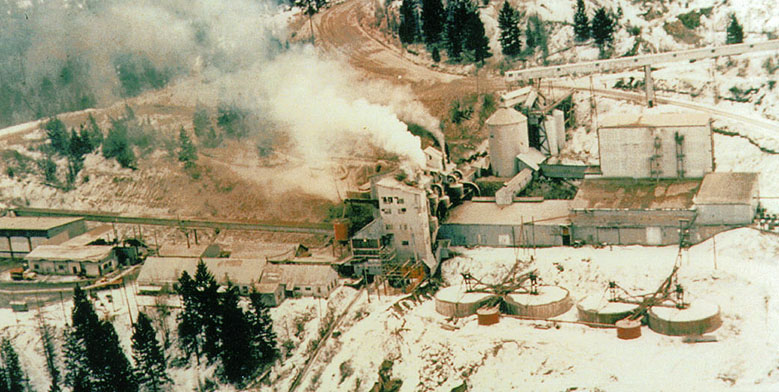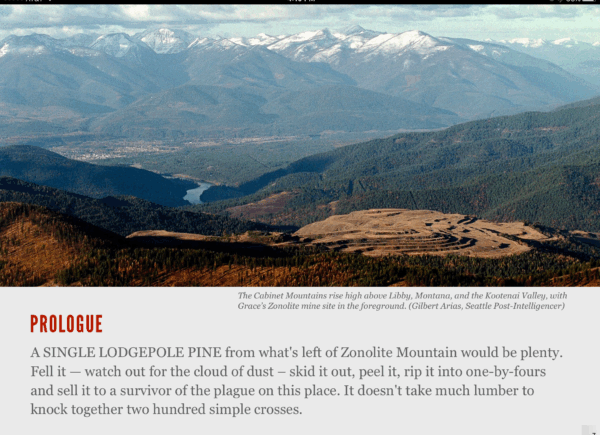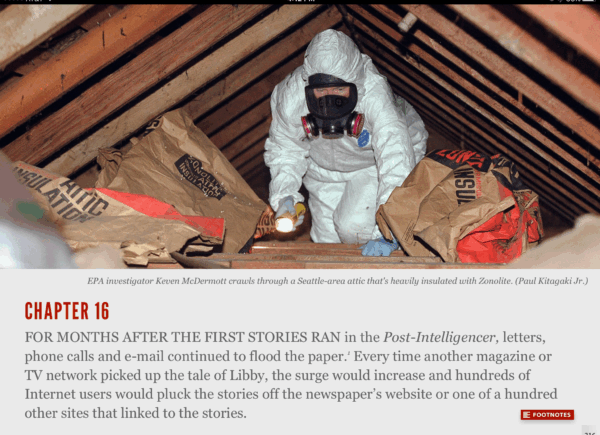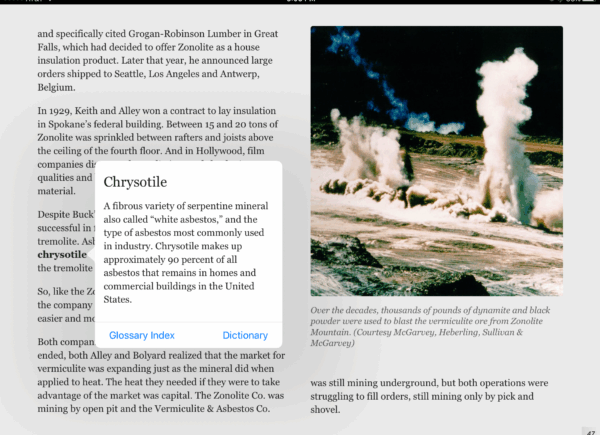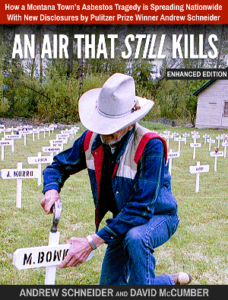 Design and publishing consulting by Tandemvines Media
Design and publishing consulting by Tandemvines Media
In 2004, authors Andrew Schneider and David McCumber told the world that a vermiculite mine near Libby, Montana, was producing asbestos-tainted ore that was poisoning townspeople and placing millions more at risk as the ore was shipped throughout the U.S. and Canada. Twelve years later, despite a decade of government cleanup, the risk that lurks in up to 50 million homes and scores of neighborhoods across the country has escalated. New research, disclosed for the first time in this update to “An Air That Kills,” shows that the lethal mineral pulled from the W.R. Grace mine in Libby destroys lives far faster and in far more ways than anyone had previously imagined.
AN AIR THAT STILL KILLS is a haunting, meticulously reported account that will introduce you to the courageous miner’s daughter and the cowboy crooner who took on Grace – one of the nation’s most powerful chemical companies – and forced the government to acknowledge it had concealed the enormous danger their town faced.
After a $500 million cleanup led by dedicated emergency responders who had to fight their own government for time and money, the Montana town south of the Canadian border has been declared “safe enough to live in’’ by the EPA.
But the front-line federal health assessment teams, toxicologists and physicians who fought EPA headquarters, Congress and the White House to complete the job now find themselves again risking their careers. As with the lead-tainted water in Flint, Mich., EPA leaders refuse to sound the alarm about the deadly dangers that hide in as many as 50 million structures insulated with vermiculite from Libby.
Schneider has added 37,000 words with distressing new findings, including:
- Libby asbestos is so highly toxic that it can be lethal at exposure levels thousands of times lower than previously known.
- It is suspected of causing autoimmune diseases, as well as cancer and asbestosis.
- No government regulators are tallying the deaths from Libby asbestos.
- Even if they wanted to quantify the death rate, many physicians lack the equipment and expertise to accurately spot or diagnose the damage caused by asbestos.
The multimedia iBook edition of AN AIR THAT STILL KILLS includes video, audio and dozens of photos documenting the mine’s impact on Libby and its people, along with source documents behind the reporting. The iBook was honored as “iBook of the Year” for 2016 by the iBooks Author Conference. A Kindle edition and a 590-page printed edition are also available. All editions take readers day-by-day through the high-stakes, 10-week criminal trial that pitted the United States v. W.R. Grace.
A FEW SAMPLE PAGES FROM THE iBOOK
Of the first 26 chapters, which appeared in the original book AN AIR THAT KILLS, The Washington Post wrote in 2004: “It is the stuff of opera, a tragic tale of greed, betrayal and corruption finally revealed – if not entirely righted – by courage and perseverance. … It is easy enough to be scandalized by this story and still assume that it is someone else’s problem. But as Schneider and McCumber remind readers, attics across America are still filled with this insulation.”
The greed, power and politics that claimed so many lives will make you furious. The stories of tireless perseverance against all odds will astonish you. And the ongoing risk of a horrifying death faced by millions should make you mad as hell.
The book is available in three formats:
A visually rich iBook, available on the iBooks Store.
In a 582-page print edition, available on Amazon.
In an ebook optimized for Kindle, available on Amazon.
More on AN AIR THAT STILL KILLS on the book’s website.
All three book formats and website designed by Tandemvines Media.
Photograph above: Grace’s mine and vermiculite processing plant spewed 5,000 pounds of asbestos fibers each day over Libby and the surrounding countryside. (McGarvey, Heberling, Sullivan & McGarvey)

